Utilizing a Combination of Network Pharmacology and Experimental Validation to Unravel the Mechanism by Which Kuanxiongzhuyu Decoction Ameliorates Myocardial Infarction Damage
Abstract
:1. Background
2. Methods
2.1. Preparation for KXZY
2.2. HPLC-MS Characterization of Primary Chemical Constituents in KXZY
2.3. Prediction and Screening of Targets
2.4. Protein–Protein Interaction (PPI) Network Construction
2.5. Gene and KEGG Analysis
2.6. Molecular Docking
2.7. Animal Model and Groups
2.8. Echocardiography
2.9. NT-proBNP in Serum
2.10. Histopathological
2.11. Western Blotting
2.12. Statistical Analysis
3. Results
3.1. Characterization of the Chemical Constituents in KXZY
3.2. Screening of the Potential Targets of KXZY in Treating MI
3.3. GO and KEGG Analysis
3.4. PPI Network Analysis
3.5. Molecular Docking Verification
3.6. KXZY Ameliorated Cardiac Dysfunction in Post-MI Mice
3.7. KXZY Activates the AKT Protein and Attenuates Myocardial Apoptosis
4. Discussion
5. Conclusions
Author Contributions
Funding
Institutional Review Board Statement
Informed Consent Statement
Data Availability Statement
Acknowledgments
Conflicts of Interest
References
- Duran, E.K.; Aday, A.W.; Cook, N.R.; Buring, J.E.; Ridker, P.M.; Pradhan, A.D. Triglyceride-Rich Lipoprotein Cholesterol, Small Dense LDL Cholesterol, and Incident Cardiovascular Disease. J. Am. Coll. Cardiol. 2020, 75, 2122–2135. [Google Scholar] [CrossRef] [PubMed]
- Danielson, K.M.; Shah, R.; Yeri, A.; Liu, X.; Camacho Garcia, F.; Silverman, M.; Tanriverdi, K.; Das, A.; Xiao, C.; Jerosch-Herold, M.; et al. Plasma Circulating Extracellular RNAs in Left Ventricular Remodeling Post-Myocardial Infarction. EBioMedicine 2018, 32, 172–181. [Google Scholar] [CrossRef] [PubMed]
- Huang, K.; Zhang, P.; Zhang, Z.; Youn, J.Y.; Wang, C.; Zhang, H.; Cai, H. Traditional Chinese Medicine (TCM) in the treatment of COVID-19 and other viral infections: Efficacies and mechanisms. Pharmacol. Ther. 2021, 225, 107843. [Google Scholar] [CrossRef] [PubMed]
- Yang, J.; Tian, S.; Zhao, J.; Zhang, W. Exploring the mechanism of TCM formulae in the treatment of different types of coronary heart disease by network pharmacology and machining learning. Pharmacol. Res. 2020, 159, 105034. [Google Scholar] [CrossRef]
- Hua, Y.Q.; Zeng, Y.; Xu, J.; Xu, X.L. Naringenin alleviates nonalcoholic steatohepatitis in middle-aged Apoe(−/−)mice: Role of SIRT1. Phytomedicine 2021, 81, 153412. [Google Scholar] [CrossRef] [PubMed]
- Zhongyin, Z.; Wei, W.; Juan, X.; Guohua, F. Isoliquiritin apioside relieves intestinal ischemia/reperfusion-induced acute lung injury by blocking Hif-1alpha-mediated ferroptosis. Int. Immunopharmacol. 2022, 108, 108852. [Google Scholar] [CrossRef]
- Gu, P.; Wusiman, A.; Wang, S.; Zhang, Y.; Liu, Z.; Hu, Y.; Liu, J.; Wang, D. Polyethylenimine-coated PLGA nanoparticles-encapsulated Angelica sinensis polysaccharide as an adjuvant to enhance immune responses. Carbohydr. Polym. 2019, 223, 115128. [Google Scholar] [CrossRef]
- Li, J.; Gong, X. Tetramethylpyrazine: An Active Ingredient of Chinese Herbal Medicine With Therapeutic Potential in Acute Kidney Injury and Renal Fibrosis. Front. Pharmacol. 2022, 13, 820071. [Google Scholar] [CrossRef]
- Zhong, Y.; Li, M.; Zhang, X.; Chen, L.; Wang, Y.; Xu, Y. Dissecting Chemical Composition and Cardioprotective Effects of Fuzhengkangfu Decoction against Doxorubicin-Induced Cardiotoxicity by LC-MS and Bioinformatics Approaches. ACS Omega 2020, 5, 14051–14060. [Google Scholar] [CrossRef]
- Liu, Z.; Guo, F.; Wang, Y.; Li, C.; Zhang, X.; Li, H.; Diao, L.; Gu, J.; Wang, W.; Li, D.; et al. BATMAN-TCM: A Bioinformatics Analysis Tool for Molecular mechANism of Traditional Chinese Medicine. Sci. Rep. 2016, 6, 21146. [Google Scholar] [CrossRef]
- Amberger, J.S.; Bocchini, C.A.; Schiettecatte, F.; Scott, A.F.; Hamosh, A. OMIM.org: Online Mendelian Inheritance in Man (OMIM(R)), an online catalog of human genes and genetic disorders. Nucleic Acids Res. 2015, 43, D789–D798. [Google Scholar] [CrossRef] [PubMed]
- Davis, A.P.; Grondin, C.J.; Johnson, R.J.; Sciaky, D.; Wiegers, J.; Wiegers, T.C.; Mattingly, C.J. Comparative Toxicogenomics Database (CTD): Update 2021. Nucleic Acids Res. 2021, 49, D1138–D1143. [Google Scholar] [CrossRef] [PubMed]
- Szklarczyk, D.; Gable, A.L.; Nastou, K.C.; Lyon, D.; Kirsch, R.; Pyysalo, S.; Doncheva, N.T.; Legeay, M.; Fang, T.; Bork, P.; et al. The STRING database in 2021: Customizable protein-protein networks, and functional characterization of user-uploaded gene/measurement sets. Nucleic Acids Res 2021, 49, D605–D612. [Google Scholar] [CrossRef] [PubMed]
- Sherman, B.T.; Hao, M.; Qiu, J.; Jiao, X.; Baseler, M.W.; Lane, H.C.; Imamichi, T.; Chang, W. DAVID: A web server for functional enrichment analysis and functional annotation of gene lists (2021 update). Nucleic Acids Res. 2022, 50, W216–W221. [Google Scholar] [CrossRef] [PubMed]
- Guo, L.; Gong, M.; Wu, S.; Qiu, F.; Ma, L. Identification and quantification of the quality markers and anti-migraine active components in Chuanxiong Rhizoma and Cyperi Rhizoma herbal pair based on chemometric analysis between chemical constituents and pharmacological effects. J. Ethnopharmacol. 2020, 246, 112228. [Google Scholar] [CrossRef] [PubMed]
- Bi, Y.; Han, X.; Lai, Y.; Fu, Y.; Li, K.; Zhang, W.; Wang, Q.; Jiang, X.; Zhou, Y.; Liang, H.; et al. Systems pharmacological study based on UHPLC-Q-Orbitrap-HRMS, network pharmacology and experimental validation to explore the potential mechanisms of Danggui-Shaoyao-San against atherosclerosis. J. Ethnopharmacol. 2021, 278, 114278. [Google Scholar] [CrossRef] [PubMed]
- Wang, M.J.; Sun, Y.; Song, Y.; Ma, J.N.; Wang, Z.Q.; Ding, X.Q.; Chen, H.Y.; Zhang, X.B.; Song, M.M.; Hu, X.M. Mechanism and Molecular Targets of Ejiao Siwu Decoction for Treating Primary Immune Thrombocytopenia Based on High-Performance Liquid Chromatograph, Network Pharmacology, Molecular Docking and Cytokines Validation. Front. Med. 2022, 9, 891230. [Google Scholar] [CrossRef]
- Chen, Y.; Dai, Y.; Xia, J.; Liu, J.; Zhou, G.; Chen, C.; Jiang, B.; Yin, L.; Li, G. Serum Pharmacochemistry Combining Network Pharmacology to Discover the Active Constituents and Effect of Xijiao Dihuang Tang Prescription for Treatment of Blood-Heat and Blood-Stasis Syndrome-Related Disease. Oxid. Med. Cell Longev. 2022, 2022, 6934812. [Google Scholar] [CrossRef]
- Zhu, Y.L.; Wang, H.J.; Xue, H.; Zhang, Y.; Cheng, Q.S.; Chen, L.Y.; Qiu, X.J. Simultaneous Determination of Five Components of Chaihu-Shugan-San in Beagle Plasma by HPLC-MS/MS and Its Application to a Pharmacokinetic Study after a Single Dose of Chaihu-Shugan-San. J. Anal. Methods Chem. 2020, 2020, 8831938. [Google Scholar] [CrossRef]
- Wang, X.; Cui, H. Application of Entropy Method to Quantify Future Ecological Flow in the Yellow River Basin. Entropy 2021, 24, 72. [Google Scholar] [CrossRef]
- Shen, P.; Lin, W.; Deng, X.; Ba, X.; Han, L.; Chen, Z.; Qin, K.; Huang, Y.; Tu, S. Potential Implications of Quercetin in Autoimmune Diseases. Front. Immunol. 2021, 12, 689044. [Google Scholar] [CrossRef]
- Ding, B.; Lin, C.; Liu, Q.; He, Y.; Ruganzu, J.B.; Jin, H.; Peng, X.; Ji, S.; Ma, Y.; Yang, W. Tanshinone IIA attenuates neuroinflammation via inhibiting RAGE/NF-kappaB signaling pathway in vivo and in vitro. J. Neuroinflamm. 2020, 17, 302. [Google Scholar] [CrossRef]
- Dhanya, R. Quercetin for managing type 2 diabetes and its complications, an insight into multitarget therapy. Biomed. Pharmacother. 2022, 146, 112560. [Google Scholar] [CrossRef] [PubMed]
- Lee, E.H.; Park, K.I.; Kim, K.Y.; Lee, J.H.; Jang, E.J.; Ku, S.K.; Kim, S.C.; Suk, H.Y.; Park, J.Y.; Baek, S.Y.; et al. Liquiritigenin inhibits hepatic fibrogenesis and TGF-beta1/Smad with Hippo/YAP signal. Phytomedicine 2019, 62, 152780. [Google Scholar] [CrossRef]
- Aihaiti, Y.; Song Cai, Y.; Tuerhong, X.; Ni Yang, Y.; Ma, Y.; Shi Zheng, H.; Xu, K.; Xu, P. Therapeutic Effects of Naringin in Rheumatoid Arthritis: Network Pharmacology and Experimental Validation. Front. Pharmacol. 2021, 12, 672054. [Google Scholar] [CrossRef]
- Vasamsetti, S.B.; Coppin, E.; Zhang, X.; Florentin, J.; Koul, S.; Gotberg, M.; Clugston, A.S.; Thoma, F.; Sembrat, J.; Bullock, G.C.; et al. Apoptosis of hematopoietic progenitor-derived adipose tissue-resident macrophages contributes to insulin resistance after myocardial infarction. Sci. Transl. Med. 2020, 12, eaaw0638. [Google Scholar] [CrossRef] [PubMed]
- Mohammadinejad, R.; Moosavi, M.A.; Tavakol, S.; Vardar, D.O.; Hosseini, A.; Rahmati, M.; Dini, L.; Hussain, S.; Mandegary, A.; Klionsky, D.J. Necrotic, apoptotic and autophagic cell fates triggered by nanoparticles. Autophagy 2019, 15, 4–33. [Google Scholar] [CrossRef]
- Wang, Z.; Qiu, Z.; Hua, S.; Yang, W.; Chen, Y.; Huang, F.; Fan, Y.; Tong, L.; Xu, T.; Tong, X.; et al. Nuclear Tkt promotes ischemic heart failure via the cleaved Parp1/Aif axis. Basic. Res. Cardiol. 2022, 117, 18. [Google Scholar] [CrossRef] [PubMed]
- Baldi, A.; Abbate, A.; Bussani, R.; Patti, G.; Melfi, R.; Angelini, A.; Dobrina, A.; Rossiello, R.; Silvestri, F.; Baldi, F.; et al. Apoptosis and post-infarction left ventricular remodeling. J. Mol. Cell Cardiol. 2002, 34, 165–174. [Google Scholar] [CrossRef]
- Wang, Y.; Li, C.; Ouyang, Y.; Shi, T.; Yang, X.; Yu, J.; Qiu, Q.; Han, J.; Wu, Y.; Tang, B.; et al. QSYQ Attenuates Oxidative Stress and Apoptosis Induced Heart Remodeling Rats through Different Subtypes of NADPH-Oxidase. Evid. Based Complement. Alternat Med. 2013, 2013, 824960. [Google Scholar] [CrossRef]
- Wang, K.; Li, Z.; Sun, Y.; Liu, X.; Ma, W.; Ding, Y.; Hong, J.; Qian, L.; Xu, D. Dapagliflozin Improves Cardiac Function, Remodeling, Myocardial Apoptosis, and Inflammatory Cytokines in Mice with Myocardial Infarction. J. Cardiovasc. Transl. Res. 2022, 15, 786–796. [Google Scholar] [CrossRef] [PubMed]
- Jaiswal, N.; Gavin, M.; Loro, E.; Sostre-Colon, J.; Roberson, P.A.; Uehara, K.; Rivera-Fuentes, N.; Neinast, M.; Arany, Z.; Kimball, S.R.; et al. AKT controls protein synthesis and oxidative metabolism via combined mTORC1 and FOXO1 signalling to govern muscle physiology. J. Cachexia Sarcopenia Muscle 2022, 13, 495–514. [Google Scholar] [CrossRef] [PubMed]
- Wang, R.; Wang, Y.; Wu, J.; Guo, Y.; Xiao, H.; Zhang, Y.; Ma, K. Resveratrol Targets AKT1 to Inhibit Inflammasome Activation in Cardiomyocytes Under Acute Sympathetic Stress. Front. Pharmacol. 2022, 13, 818127. [Google Scholar] [CrossRef] [PubMed]
- Xiong, Y.; Lu, H.; Xu, H. Galangin Reverses Hepatic Fibrosis by Inducing HSCs Apoptosis via the PI3K/Akt, Bax/Bcl-2, and Wnt/beta-Catenin Pathway in LX-2 Cells. Biol. Pharm. Bull. 2020, 43, 1634–1642. [Google Scholar] [CrossRef] [PubMed]
- Jing, Z.T.; Liu, W.; Xue, C.R.; Wu, S.X.; Chen, W.N.; Lin, X.J.; Lin, X. AKT activator SC79 protects hepatocytes from TNF-alpha-mediated apoptosis and alleviates d-Gal/LPS-induced liver injury. Am. J. Physiol. Gastrointest. Liver Physiol. 2019, 316, G387–G396. [Google Scholar] [CrossRef] [PubMed]

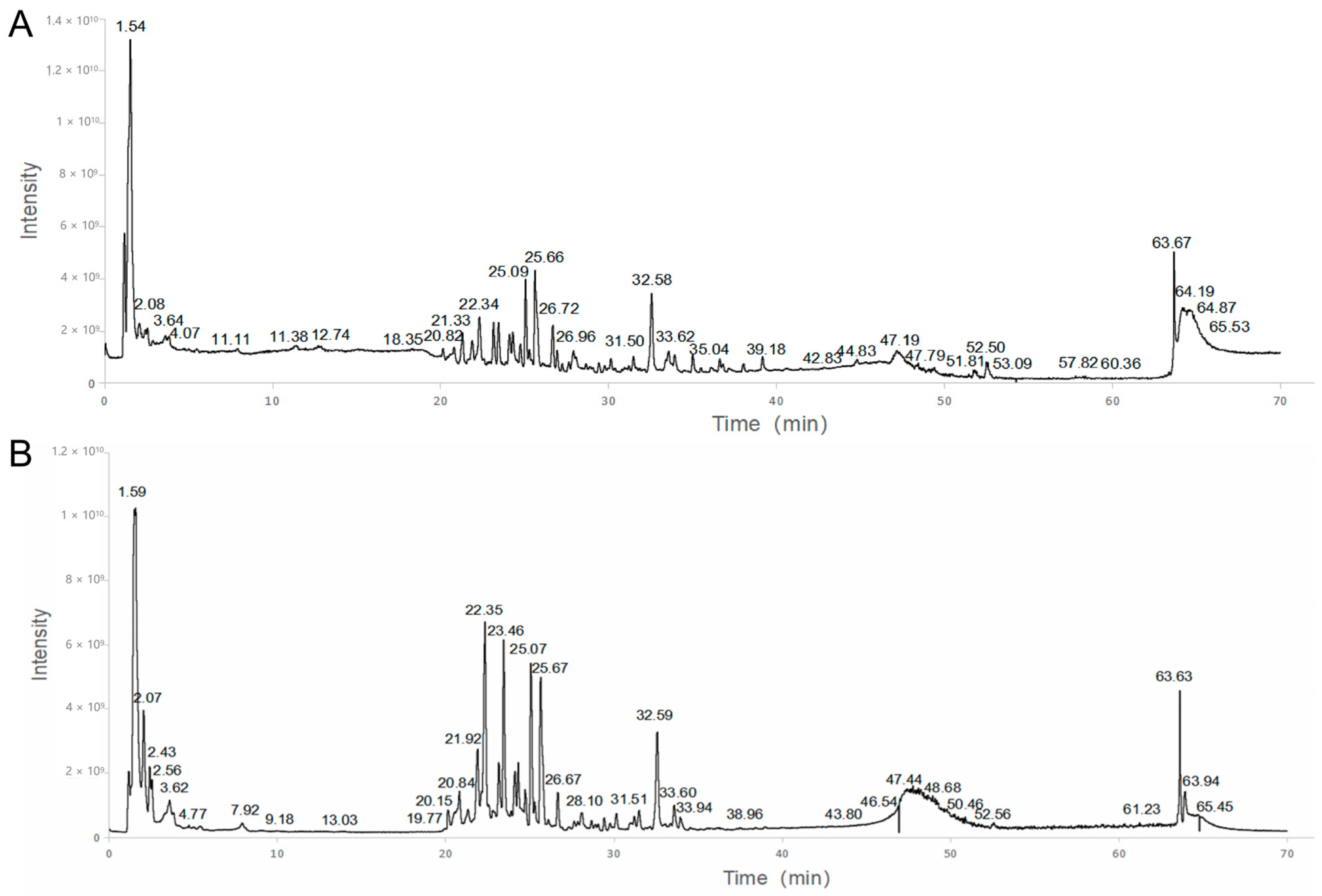
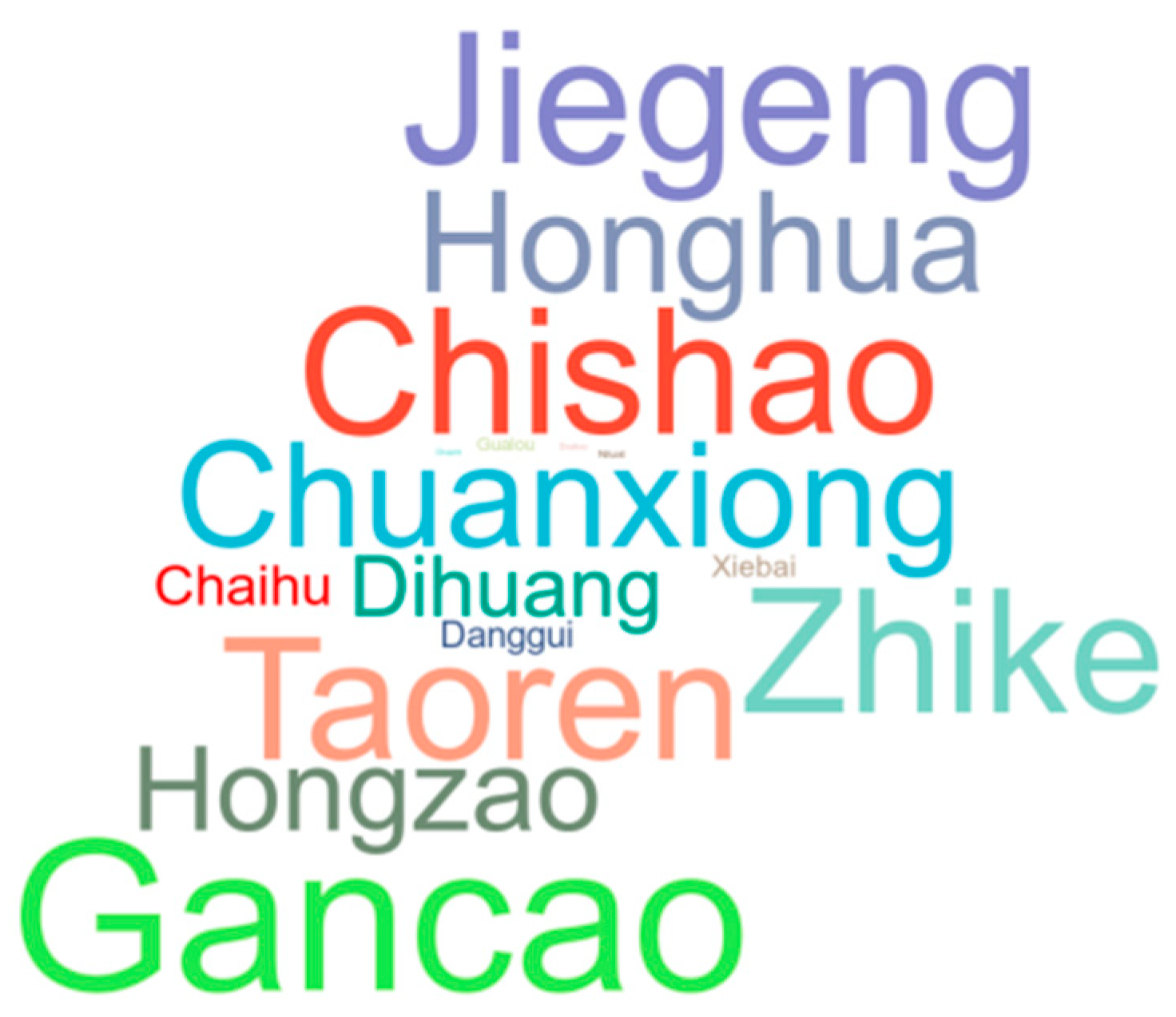

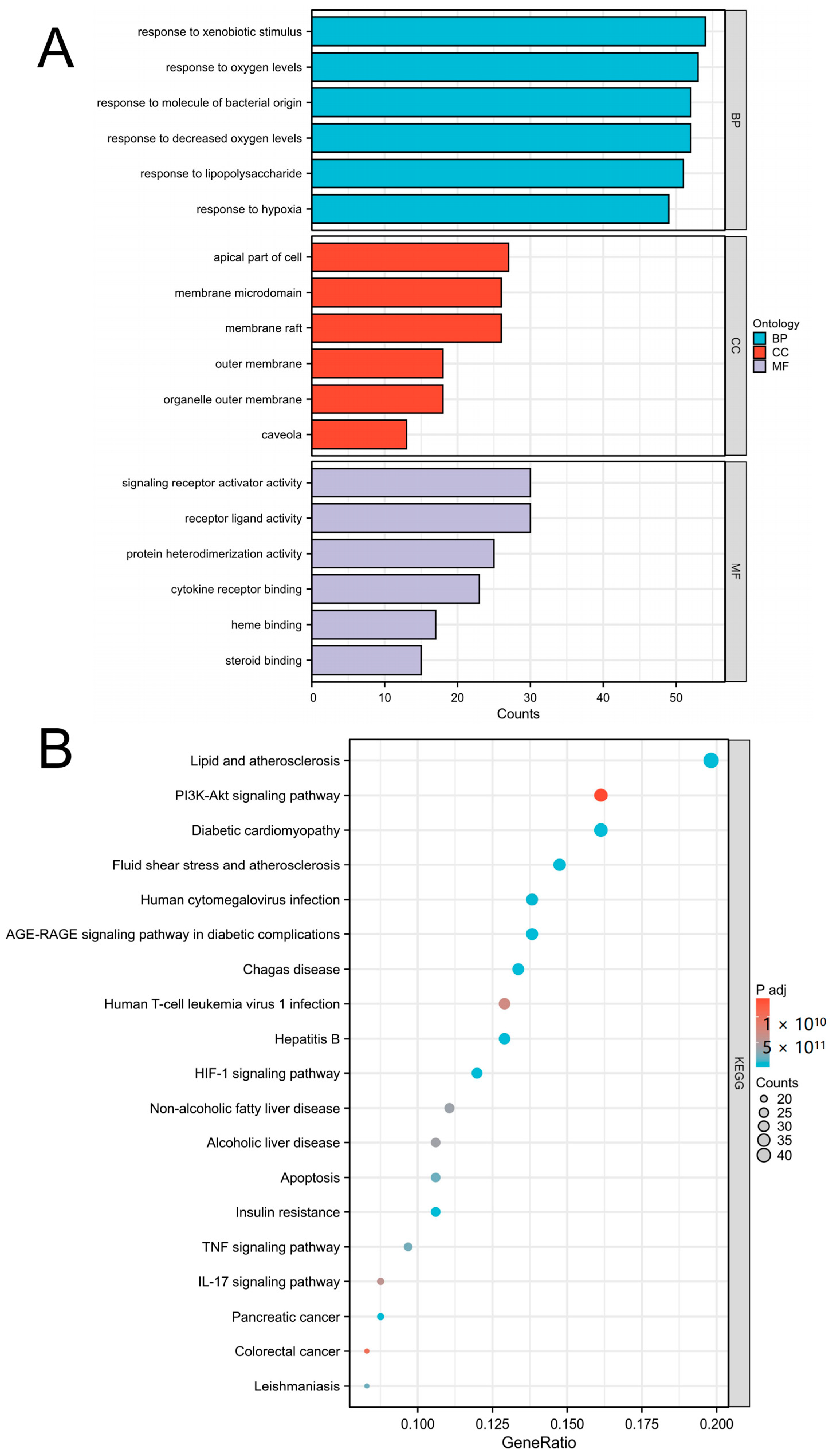
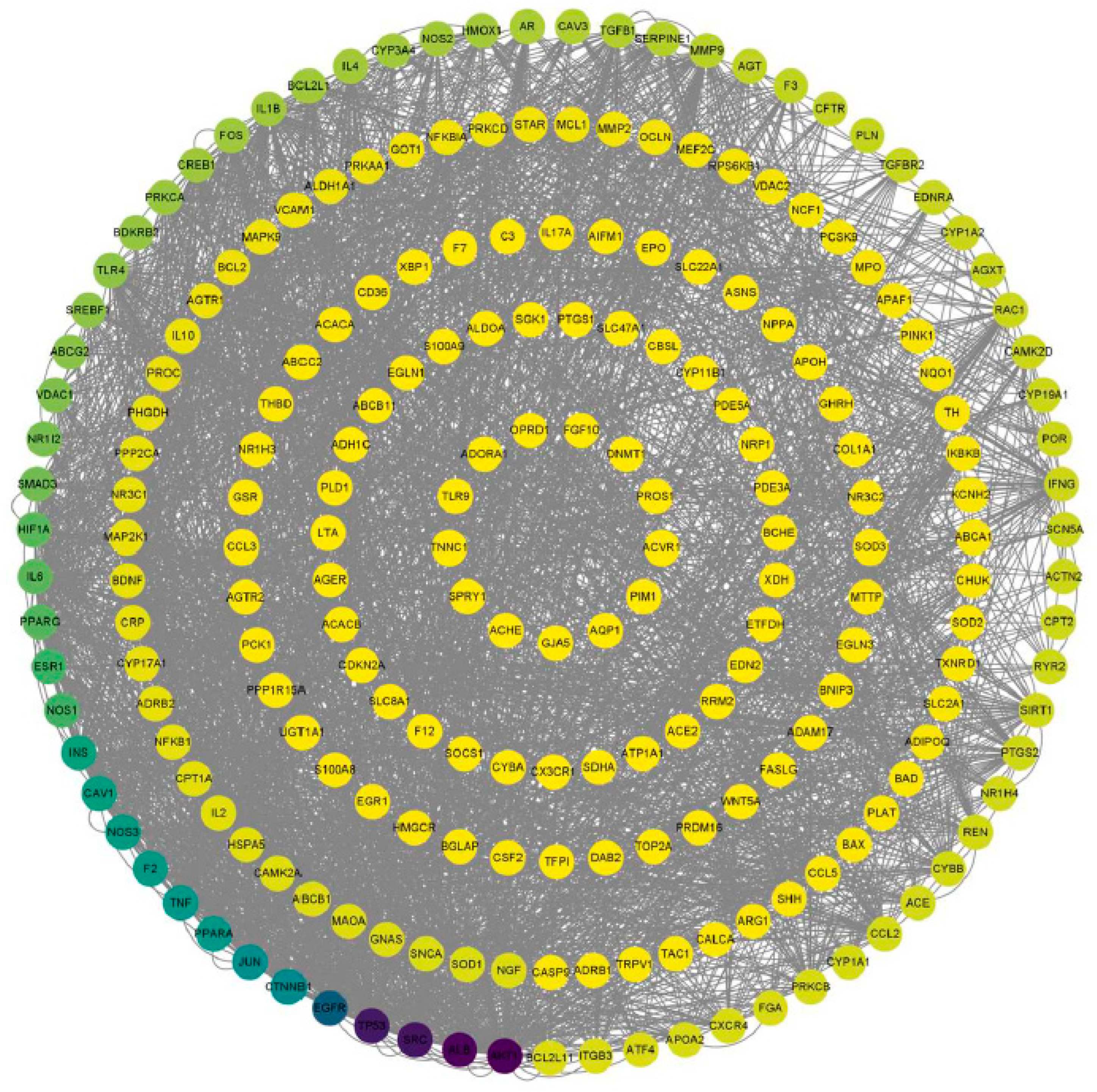

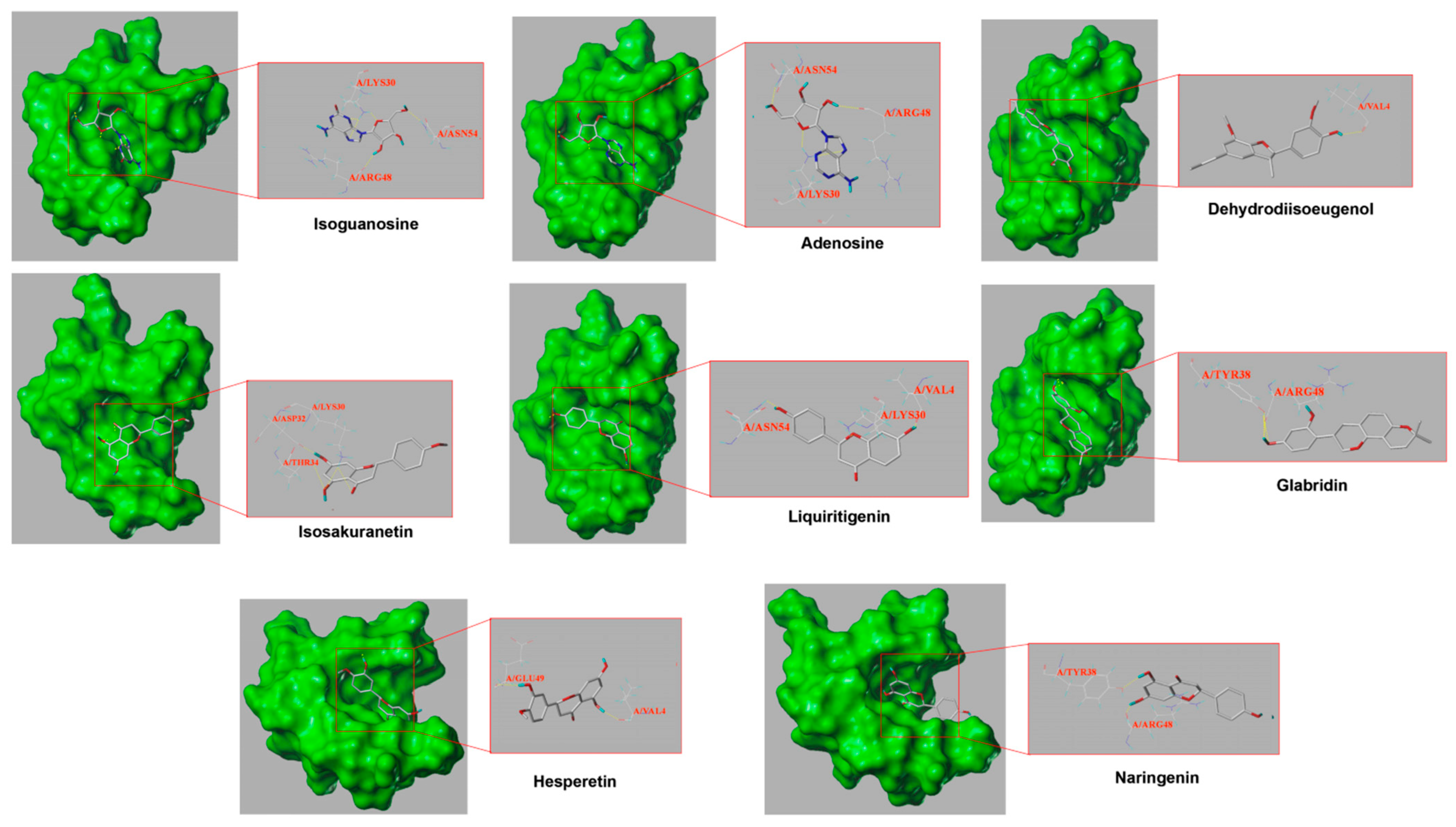
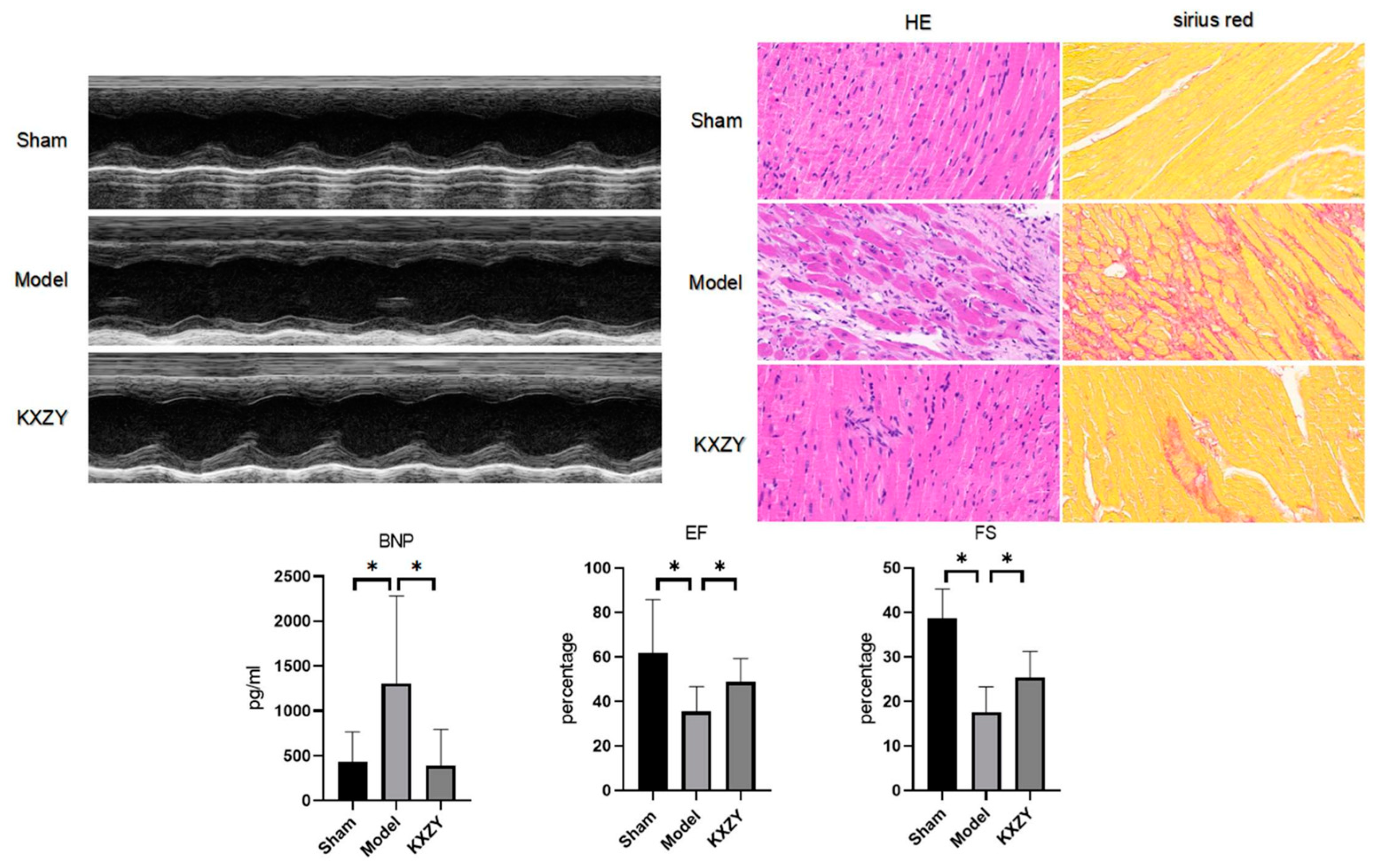
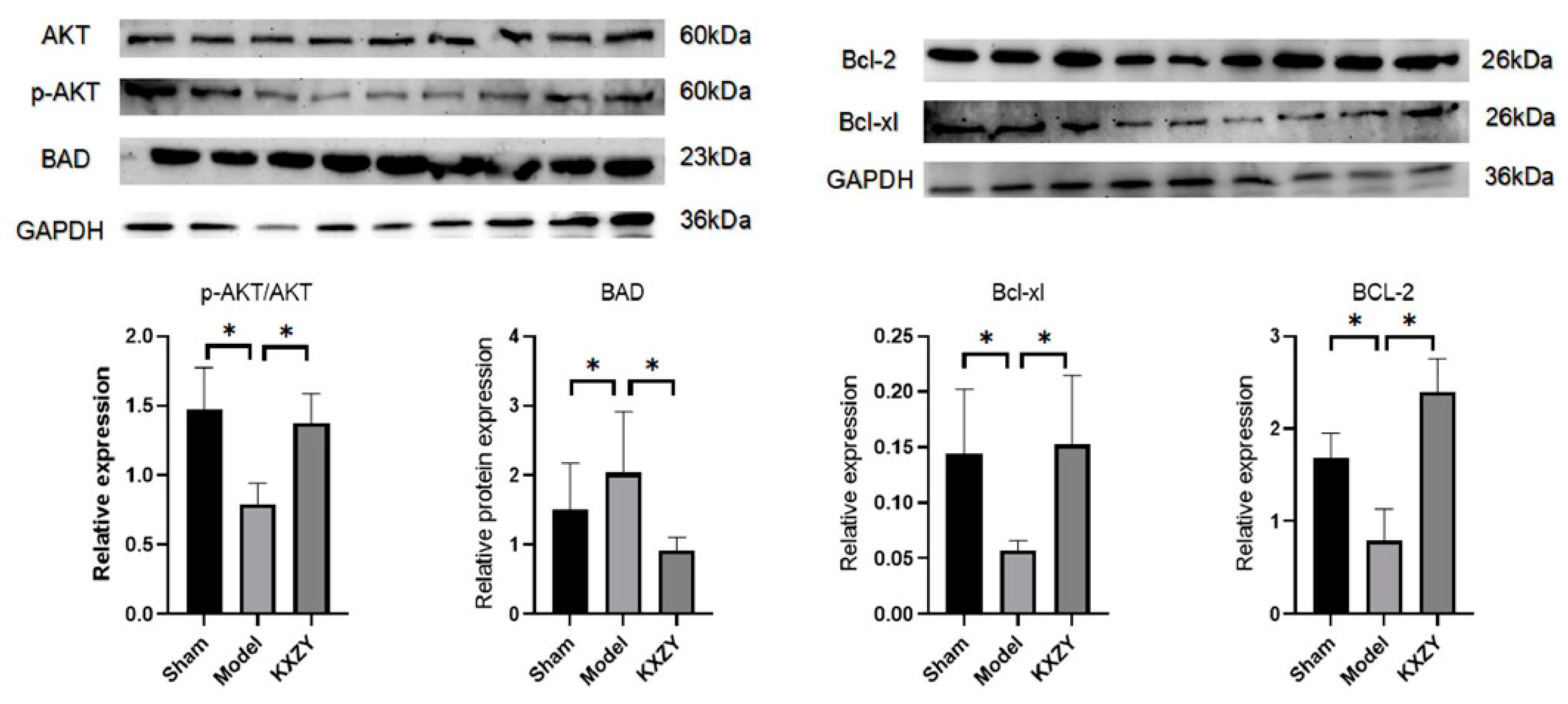
| Latin Name | Chinese Name | Content (g) | Latin Name | Chinese Name | Content (g) |
|---|---|---|---|---|---|
| Conioselinum Chuanxiong | Chuanxiong | 15 | Prunus persica (L.) Batsch | Taoren | 15 |
| Paeonia lactiflora Pall. | Chishao | 15 | Carthamus tinctorius L. | Honghua | 10 |
| Rehmannia glutinosa (Gaertn.) DC. | Dihuang | 15 | Citrus aurantium L. | Zhike | 12 |
| Angelica sinensis (Oliv.) Diels | Danggui | 12 | Bupleurum chinense DC. | Chaihu | 10 |
| Achyranthes bidentata Blume | niuxi | 10 | Trichosanthes kirilowii Maxim. | Gualou | 10 |
| Allium macrostemon Bunge | Xiebai | 10 | Ziziphus jujuba Mill. | Hongzao | 15 |
| Hirudo nipponica Whitman. | Shuizhi | 5 | Alpinia katsumadai Hayata | Doukou | 5 |
| Platycodon grandiflorus A.DC. | Jiegeng | 5 | Glycyrrhiza uralensis Fisch. ex DC. | Gancao | 8 |
| No. | Formula | m/z | tR (min) | Relative Content (%) | Identity |
|---|---|---|---|---|---|
| 1 | C20H27NO11 | 457.15851 | 22.524 | 9.113 | Amygdalin |
| 2 | C27H32O14 | 580.17929 | 25.259 | 6.855 | Naringin |
| 3 | C23H28O11 | 480.16329 | 23.642 | 6.453 | Paeoniflorin |
| 4 | C28H34O15 | 610.18975 | 25.837 | 6.118 | Neohesperidin |
| 5 | C42H62O16 | 822.40393 | 32.766 | 5.017 | Diammonium glycyrrhizinate |
| 6 | C5H11NO2 | 117.07898 | 1.692 | 4.596 | Betaine |
| 7 | C12H22O11 | 342.11622 | 1.754 | 4.577 | Sucrose |
| 8 | C7H13NO2 | 143.09474 | 1.745 | 3.164 | Stachydrine |
| 9 | C27H32O16 | 612.16911 | 22.087 | 3.146 | Safflomin A |
| 10 | C30H46O4 | 470.3395 | 32.769 | 3.117 | 18 β-Glycyrrhetintic Acid |
| 11 | C5H9NO2 | 115.06339 | 1.738 | 2.576 | 2-Pyrrolidinecarboxylic acid |
| 12 | C6H8O7 | 192.02709 | 1.85 | 2.55 | Citric acid |
| 13 | C15H12O5 | 272.06828 | 25.261 | 2.538 | Naringenin |
| 14 | C16H14O6 | 140.04846 | 25.822 | 2.427 | Hesperetin |
| 15 | C23H28O11 | 526.16871 | 23.362 | 2.405 | Albiflorin |
| 16 | C21H22O9 | 418.12653 | 24.504 | 2.018 | Liquiritin |
| 17 | C15H12O4 | 256.07341 | 24.51 | 1.744 | Isoliquiritigenin |
| 18 | C21H18O11 | 446.08497 | 26.856 | 1.446 | Baicalin |
| 19 | C21H22O8 | 402.13164 | 35.226 | 1.328 | Nobiletin |
| 20 | C20H17NO4 | 335.11565 | 28.127 | 1.272 | Epiberberine |
| 21 | C16H18O9 | 354.09513 | 22.341 | 1.188 | Cryptochlorogenic acid |
| 22 | C9H11NO2 | 165.07916 | 12.97 | 1.168 | L-Phenylalanine |
| 23 | C24H42O21 | 666.22231 | 2.624 | 0.943 | Stachyose |
| 24 | C7H7NO2 | 137.04779 | 1.742 | 0.886 | Trigonelline HCl |
| 25 | C12H16O2 | 192.1152 | 36.831 | 0.874 | Senkyunolide A |
| 26 | C27H32O14 | 580.17937 | 24.925 | 0.86 | Narirutin |
| 27 | C15H22O10 | 362.12149 | 8.096 | 0.834 | Catalpol |
| 28 | C10H12O4 | 196.07357 | 25.953 | 0.788 | Xanthoxyline |
| 29 | C10H13N5O4 | 267.09683 | 11.509 | 0.754 | Adenosine |
| 30 | C7H12O6 | 192.06343 | 1.739 | 0.746 | Quinic acid |
| 31 | C26H30O8 | 470.19427 | 34.14 | 0.714 | Limonin |
| 32 | C18H32O16 | 504.16943 | 2.743 | 0.678 | Manninotriose |
| 33 | C20H20O7 | 372.12099 | 37.022 | 0.58 | Tangeretin |
| 34 | C15H24O9 | 348.14228 | 21.05 | 0.564 | Ajugol |
| 35 | C30H46O5 | 486.33467 | 30.333 | 0.515 | Quillaic acid |
| 36 | C27H44O7 | 526.31422 | 24.34 | 0.509 | Hydroxyecdysone |
| 37 | C6H6O3 | 126.03174 | 1.762 | 0.489 | 5-Hydroxymethylfurfural |
| 38 | C30H32O12 | 584.18985 | 29.607 | 0.479 | Benzoylpaeoniflorin |
| 39 | C7H6O5 | 170.0216 | 8.27 | 0.436 | Gallic acid |
| 40 | C22H20O11 | 460.10069 | 28.866 | 0.422 | Wogonoside |
| 41 | C22H22O9 | 430.12642 | 26.899 | 0.401 | Ononin |
| 42 | C10H8O3 | 144.02113 | 24.981 | 0.385 | 7-Methoxycoumarin |
| 43 | C5H9NO4 | 147.05327 | 1.624 | 0.354 | L-Glutamic acid |
| 44 | C15H16O4 | 260.1049 | 33.622 | 0.34 | Isomeranzin |
| 45 | C42H68O13 | 780.46643 | 33.774 | 0.304 | Saikosaponin D |
| 46 | C6H14O6 | 182.07915 | 1.641 | 0.294 | Mannitol |
| 47 | C21H21NO4 | 351.14708 | 27.846 | 0.272 | Palmatine |
| 48 | C10H12O4 | 196.07359 | 23.36 | 0.265 | Cantharidin |
| 49 | C10H10O4 | 194.05791 | 24.982 | 0.261 | Ferulic acid |
| 50 | C20H23NO4 | 341.16277 | 23.188 | 0.252 | (+)-Magnoflorine |
| 51 | C21H22O9 | 418.12648 | 26.829 | 0.252 | Isoliquiritin |
| 52 | C9H8O | 132.05754 | 25.953 | 0.245 | Cinnamaldehyde |
| 53 | C15H12O4 | 256.07353 | 28.242 | 0.243 | Liquiritigenin |
| 54 | C30H46O3 | 454.3452 | 33.827 | 0.225 | Wilforlide A |
| 55 | C6H6O3 | 126.0317 | 8.277 | 0.212 | Pyrogallol |
| 56 | C22H20O11 | 460.10067 | 28.266 | 0.208 | Oroxylin A-7-O-β-D-glucuronide |
| 57 | C6H13NO2 | 131.09473 | 5.241 | 0.203 | L-Leucine |
| 58 | C28H34O14 | 594.19521 | 28.294 | 0.187 | Poncirin |
| 59 | C20H20O7 | 372.12102 | 33.602 | 0.187 | Sinensetin |
| 60 | C42H66O14 | 794.44569 | 32.631 | 0.184 | Chikusetsu saponin IVa |
| 61 | C30H44O4 | 468.32408 | 31.685 | 0.184 | Glabrolide |
| 62 | C10H13N5O5 | 283.09178 | 14.099 | 0.18 | Isoguanosine |
| 63 | C27H30O15 | 594.1589 | 24.846 | 0.177 | Kaempferol-3-O-rutinoside |
| 64 | C27H30O14 | 578.16362 | 25.254 | 0.173 | Rhoifolin |
| 65 | C57H92O28 | 1224.57672 | 28.035 | 0.161 | Platycodin D |
| 66 | C27H30O15 | 594.1589 | 22.692 | 0.156 | Vicenin II |
| 67 | C12H14O2 | 190.09939 | 32.818 | 0.153 | Ligustilide |
| 68 | C30H52O26 | 828.275 | 1.778 | 0.152 | Maltopentaose |
| 69 | C15H10O5 | 270.05236 | 26.861 | 0.149 | Baicalein |
| 70 | C15H12O6 | 288.06331 | 24.278 | 0.144 | Eriodictyol |
| 71 | C16H12O4 | 268.07334 | 32.693 | 0.142 | Formononetin |
| 72 | C25H24O12 | 516.12675 | 25.335 | 0.142 | 1,3-Dicaffeoylquinic acid |
| 73 | C25H24O12 | 516.12676 | 25.787 | 0.134 | Isochlorogenic acid C |
| 74 | C12H12O2 | 188.08374 | 32.605 | 0.131 | 3-Butylidenephthalide |
| 75 | C9H16O4 | 188.105 | 26.189 | 0.131 | Azelaic acid |
| 76 | C16H14O5 | 286.08406 | 28.285 | 0.13 | Isosakuranetin |
| 77 | C19H18O6 | 342.11037 | 33.683 | 0.126 | 6-Demethoxytangeretin |
| 78 | C9H8O3 | 164.04756 | 5.706 | 0.114 | p-Coumaric acid |
| 79 | C22H23NO4 | 365.1628 | 28.557 | 0.114 | Dehydrocorydaline |
| 80 | C23H28O12 | 382.1653 | 22.165 | 0.114 | Oxypaeoniflorin |
| 81 | C26H28O14 | 564.14811 | 23.27 | 0.111 | Vicenin III |
| 82 | C20H20O7 | 372.12108 | 32.049 | 0.109 | Isosinensetin |
| 83 | C15H12O5 | 272.06846 | 30.387 | 0.102 | Naringenin chalcone |
| 84 | C29H36O15 | 624.20546 | 24.312 | 0.1 | Verbascoside |
| 85 | C16H12O5 | 284.06848 | 34.93 | 0.099 | Wogonin |
| 86 | C42H60O16 | 822.40294 | 33.795 | 0.098 | Dipotassium glycyrrhizinate |
| 87 | C27H30O16 | 610.15368 | 24.106 | 0.097 | Rutin |
| 88 | C20H19NO4 | 337.13146 | 26.237 | 0.095 | Jatrorrhizine |
| 89 | C7H6O3 | 138.03174 | 26.741 | 0.095 | 4-Hydroxybenzoic acid |
| 90 | C16H24O10 | 376.1371 | 21.383 | 0.095 | Loganic acid |
| 91 | C7H6O3 | 138.03172 | 21.807 | 0.091 | Protocatechualdehyde |
| 92 | C18H32O16 | 550.175 | 3.46 | 0.089 | Raffinose |
| 93 | C19H15N3O | 301.12157 | 26.661 | 0.088 | Dehydroevodiamine |
| 94 | C16H12O5 | 284.06854 | 28.64 | 0.088 | Calycosin |
| 95 | C21H20O11 | 448.10066 | 25.412 | 0.084 | Quercitrin |
| 96 | C25H24O12 | 516.12678 | 24.963 | 0.082 | Isochlorogenic acid B |
| 97 | C27H43NO3 | 429.32436 | 26.086 | 0.08 | Peiminine |
| 98 | C26H30O7 | 454.19936 | 37.521 | 0.076 | Obacunone |
| 99 | C9H12N2O6 | 244.06961 | 6.015 | 0.075 | Uridine |
| 100 | C11H12N2O2 | 204.08999 | 21.475 | 0.074 | L-Tryptophan L |
| 101 | C21H20O12 | 464.09576 | 24.538 | 0.073 | Hyperoside |
| 102 | C52H84O24 | 1092.53526 | 27.843 | 0.068 | Desapioplatycodin D |
| 103 | C16H14O5 | 264.10208 | 27.739 | 0.066 | Licochalcone B |
| 104 | C28H32O15 | 608.17464 | 25.652 | 0.064 | Diosmin |
| 105 | C48H78O17 | 926.52433 | 31.227 | 0.06 | Saikosaponin C |
| 106 | C45H76O19 | 920.49865 | 26.796 | 0.057 | Timosaponin B II |
| 107 | C10H10O3 | 178.06295 | 23.362 | 0.054 | Ferulaldehyde |
| 108 | C9H6O3 | 162.03176 | 31.867 | 0.052 | 7-Hydroxycoumarin |
| 109 | C9H11NO3 | 164.04756 | 1.93 | 0.052 | L-Tyrosine |
| 110 | C16H22O10 | 374.12135 | 21.063 | 0.051 | Geniposidic acid |
| 111 | C21H20O6 | 368.12612 | 35.986 | 0.05 | Icaritin |
| 112 | C15H10O6 | 286.04769 | 24.836 | 0.046 | Kaempferol |
| 113 | C21H34O14 | 510.1951 | 20.891 | 0.042 | Rehmannioside C |
| 114 | C12H14O2 | 190.09938 | 37.346 | 0.04 | 3-n-Butylphathlide |
| 115 | C15H10O4 | 254.05791 | 27.861 | 0.04 | Daidzein |
| 116 | C20H20O8 | 388.11583 | 32.396 | 0.038 | 5-O-Demethylnobiletin |
| 117 | C16H14O4 | 270.08924 | 30.378 | 0.037 | Retrochalcone |
| 118 | C9H6O4 | 178.0267 | 23.198 | 0.036 | 5,7-Dihydroxychromone |
| 119 | C16H22O9 | 404.13197 | 23.024 | 0.033 | Sweroside |
| 120 | C21H18O13 | 478.07471 | 24.543 | 0.032 | Quercetin 3-O-β-D-Glucuronide |
| 121 | C9H8O2 | 148.05246 | 24.979 | 0.032 | Cinnamic acid |
| 122 | C42H62O16 | 822.40337 | 34.38 | 0.032 | Glycyrrhizic acid |
| 123 | C9H6O4 | 178.0267 | 22.957 | 0.031 | Esculetin |
| 124 | C27H45NO3 | 431.34023 | 27.45 | 0.031 | Peimine |
| 125 | C22H33NO4 | 375.24114 | 25.149 | 0.031 | Tuberostemonine |
| 126 | C39H64O13 | 740.4348 | 26.791 | 0.03 | Timosaponin A-III |
| 127 | C15H10O6 | 286.04784 | 28.573 | 0.029 | Luteolin |
| 128 | C19H21NO2 | 295.1573 | 27.028 | 0.029 | Nuciferine |
| 129 | C17H24O11 | 404.13197 | 23.398 | 0.028 | Secoxyloganin |
| 130 | C16H20O9 | 356.11076 | 22.001 | 0.028 | Gentiopicrin |
| 131 | C21H20O11 | 448.10059 | 24.572 | 0.028 | Cynaroside |
| 132 | C22H20O12 | 476.09565 | 28.42 | 0.027 | Scutellarin methyl ester |
| 133 | C20H28O8 | 442.18434 | 26.17 | 0.027 | Lobetyolin |
| 134 | C5H5N5 | 135.05459 | 11.536 | 0.026 | Adenine |
| 135 | C21H20O10 | 450.1163 | 24.284 | 0.026 | Vitexin |
| 136 | C18H18O2 | 266.13081 | 41.291 | 0.026 | Magnolol |
| 137 | C15H14O6 | 290.07891 | 22.367 | 0.025 | Epicatechin |
| 138 | C16H12O5 | 284.06852 | 35.699 | 0.025 | Oroxylin A |
| 139 | C20H22O4 | 294.12567 | 26.507 | 0.025 | Dehydrodiisoeugenol |
| 140 | C15H10O5 | 270.05266 | 30.521 | 0.025 | Genistein |
| 141 | C18H19NO4 | 313.13127 | 22.768 | 0.025 | Norisoboldine |
| 142 | C16H12O6 | 300.06334 | 28.226 | 0.025 | Tectorigenin |
| 143 | C15H22O9 | 346.12661 | 20.597 | 0.024 | Aucubin |
| 144 | C11H10O4 | 206.05811 | 27.335 | 0.024 | Scoparone |
| 145 | C35H46O20 | 786.25868 | 22.772 | 0.024 | Purpureaside C |
| 146 | C21H32O15 | 570.17995 | 6.237 | 0.024 | Rehmannioside A |
| 147 | C8H8O4 | 168.0422 | 21.029 | 0.023 | 4-Methoxysalicylic acid |
| 148 | C20H18O8 | 386.10022 | 34.413 | 0.022 | Irisflorentin |
| 149 | C16H12O7 | 316.05809 | 24.915 | 0.022 | Isorhamnetin |
| 150 | C20H19NO5 | 353.1263 | 25.591 | 0.022 | Hydroprotopine |
| 151 | C19H18O7 | 358.10536 | 35.719 | 0.022 | Gardenin B |
| 152 | C16H12O5 | 284.06855 | 28.26 | 0.021 | Glycitein |
| 153 | C24H42O21 | 712.2278 | 5.877 | 0.021 | Nystose |
| 154 | C22H22O10 | 446.12151 | 24.231 | 0.019 | Calycosin-7-O-β-D-glucoside |
| 155 | C27H41NO3 | 427.30892 | 25.186 | 0.019 | Peimisine |
| 156 | C15H10O7 | 302.04253 | 24.115 | 0.019 | Quercetin |
| 157 | C17H14O7 | 330.07405 | 33.267 | 0.019 | Aurantio-obtusin |
| 158 | C15H18O2 | 230.13088 | 36.582 | 0.018 | Dehydrocostus lactone |
| 159 | C12H8O4 | 234.05279 | 32.869 | 0.018 | Isobergapten |
| 160 | C21H20O9 | 416.11067 | 23.918 | 0.018 | Daidzin |
| 161 | C21H32O15 | 524.17443 | 20.594 | 0.018 | Melittoside |
| 162 | C18H13N3O | 287.10588 | 37.293 | 0.018 | Rutaecarpine |
| 163 | C9H6O2 | 146.03679 | 23.242 | 0.018 | Coumarin |
| 164 | C24H28O4 | 380.19884 | 45.529 | 0.018 | Levistilide A |
| 165 | C17H26O10 | 436.15822 | 22.743 | 0.018 | Loganin |
| 166 | C19H15NO4 | 321.10017 | 36.512 | 0.017 | Berberrubine |
| 167 | C18H16O8 | 360.08458 | 31.507 | 0.015 | Irigenin |
| 168 | C21H20O10 | 432.10584 | 25.616 | 0.015 | Apigenin-7-O-β-D-glucoside |
| 169 | C26H30O9 | 486.18927 | 33.151 | 0.014 | Rutaevin |
| 170 | C19H17N3O | 303.13722 | 36.5 | 0.014 | Evodiamine |
| 171 | C22H24O10 | 224.06841 | 24.951 | 0.013 | Isosakuranin |
| 172 | C15H20O2 | 232.14639 | 40.664 | 0.013 | Atractylenolide II |
| 173 | C18H16O8 | 360.08497 | 26.104 | 0.012 | Rosmarinic acid |
| 174 | C20H28O10 | 428.16835 | 25.585 | 0.012 | Rosarin |
| 175 | C19H17NO4 | 323.11583 | 26.413 | 0.011 | Tetrahydrocoptisine |
| 176 | C28H34O14 | 594.19519 | 27.919 | 0.011 | Didymin |
| 177 | C21H20O10 | 432.1057 | 28.54 | 0.011 | Emodin-8-O-β-D-glucopyranoside |
| 178 | C21H22O7 | 403.16338 | 41.635 | 0.011 | Praeruptorin A |
| 179 | C21H18O12 | 462.08028 | 26.146 | 0.01 | Luteolin 7-glucuronide |
| 180 | C18H30O2 | 278.22466 | 38.627 | 0.01 | α-Linolenic acid |
| 181 | C21H22O4 | 338.15209 | 37.984 | 0.009 | Licochalcone A |
| 182 | C15H20O4 | 264.13609 | 28.098 | 0.009 | Abscisic acid |
| 183 | C13H10O5 | 246.0529 | 32.952 | 0.009 | Pimpinellin |
| 184 | C16H14O4 | 270.08934 | 36.737 | 0.009 | Medicarpin |
| 185 | C12H8O4 | 216.04244 | 31.373 | 0.008 | 8-Methoxypsoralen |
| 186 | C47H76O18 | 974.50917 | 29.657 | 0.008 | Asperosaponin VI |
| 187 | C11H6O3 | 186.03176 | 30.685 | 0.008 | Isopsoralen |
| 188 | C15H12O7 | 304.05852 | 25.151 | 0.008 | Taxifolin |
| 189 | C16H16O6 | 304.09474 | 28.479 | 0.007 | Oxypeucedanin hydrate |
| 190 | C20H20O4 | 324.13641 | 39.171 | 0.006 | Glabridin |
| 191 | C20H18O4 | 322.12059 | 35.923 | 0.005 | Neobavaisoflavone |
| 192 | C21H20O9 | 416.11113 | 25.55 | 0.005 | Puerarin |
| 193 | C31H42O17 | 686.24281 | 22.974 | 0.003 | Specnuezhenide |
| No. | Target | Betweenness Centrality |
|---|---|---|
| 1 | AKT1 | 4289.0713 |
| 2 | ALB | 4197.868 |
| 3 | SRC | 3918.9045 |
| 4 | TP53 | 3871.7322 |
| 5 | EGFR | 2956.3945 |
| 6 | CTNNB1 | 2277.677 |
| 7 | JUN | 2211.387 |
| 8 | PPARA | 2030.4283 |
| 9 | TNF | 2015.5178 |
| 10 | F2 | 1972.6385 |
| Components | Total Score | Crash | Polar |
|---|---|---|---|
| Isoguanosine | 5.5657 | −1.3847 | 3.363 |
| Naringenin | 3.4565 | −1.8875 | 1.8116 |
| Liquiritigenin | 4.6422 | −1.018 | 0.8693 |
| Isosakuranetin | 3.96 | −0.7319 | 1.52 |
| Hesperetin | 5.1629 | −1.702 | 1.9341 |
| Dehydrodiisoeugenol | 5.3929 | −1.1121 | 0.8985 |
| Glabridin | 5.1382 | −1.3798 | 1.0598 |
| Adenosine | 5.5657 | −1.3847 | 3.3634 |
Disclaimer/Publisher’s Note: The statements, opinions and data contained in all publications are solely those of the individual author(s) and contributor(s) and not of MDPI and/or the editor(s). MDPI and/or the editor(s) disclaim responsibility for any injury to people or property resulting from any ideas, methods, instructions or products referred to in the content. |
© 2023 by the authors. Licensee MDPI, Basel, Switzerland. This article is an open access article distributed under the terms and conditions of the Creative Commons Attribution (CC BY) license (https://creativecommons.org/licenses/by/4.0/).
Share and Cite
Wu, Y.; Li, M.; Chen, L.; Xu, L.; Xu, Y.; Zhong, Y. Utilizing a Combination of Network Pharmacology and Experimental Validation to Unravel the Mechanism by Which Kuanxiongzhuyu Decoction Ameliorates Myocardial Infarction Damage. Medicina 2023, 59, 1740. https://doi.org/10.3390/medicina59101740
Wu Y, Li M, Chen L, Xu L, Xu Y, Zhong Y. Utilizing a Combination of Network Pharmacology and Experimental Validation to Unravel the Mechanism by Which Kuanxiongzhuyu Decoction Ameliorates Myocardial Infarction Damage. Medicina. 2023; 59(10):1740. https://doi.org/10.3390/medicina59101740
Chicago/Turabian StyleWu, Yihao, Miaofu Li, Liuying Chen, Linhao Xu, Yizhou Xu, and Yigang Zhong. 2023. "Utilizing a Combination of Network Pharmacology and Experimental Validation to Unravel the Mechanism by Which Kuanxiongzhuyu Decoction Ameliorates Myocardial Infarction Damage" Medicina 59, no. 10: 1740. https://doi.org/10.3390/medicina59101740
APA StyleWu, Y., Li, M., Chen, L., Xu, L., Xu, Y., & Zhong, Y. (2023). Utilizing a Combination of Network Pharmacology and Experimental Validation to Unravel the Mechanism by Which Kuanxiongzhuyu Decoction Ameliorates Myocardial Infarction Damage. Medicina, 59(10), 1740. https://doi.org/10.3390/medicina59101740





